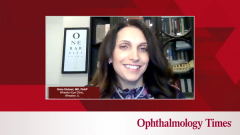
Myopia Patient Case #1
Dr Noha Ekdawi discusses her approach to managing myopia in an 8-year-old child using low-dose atropine and tracks the child’s myopia progression over the course of 5 years.
Episodes in this series
Noha Ekdawi, MD, FAAP: My name is Noha Ekdawi. I’m a pediatric ophthalmologist at Wheaton Eye Clinic [in Wheaton, Illinois]. I’ve been doing myopia management for the last 10 years, and I’ve picked some cases to discuss today.
Patient case 1: This is an 8-year-old who initially presented to me with a very strong family history of myopia. She is otherwise healthy, no complications, no prematurity. Mom, as you see, is a -8. Dad is even higher, -11, and maternal grandfather had a retinal detachment.
This family was very keen on myopia management. I first saw them in September of 2017, and the child was only -1 and a quarter, but again, the parents were very eager to start myopia management, and so I started, at that time, my dose was 0.01%. I saw them back a little over a year later in November of 2018, and she had progressed quite significantly. She went from -1 to a -2.25, then -1 to -2.5. You see there’s a significant progression here of a 1 diopter in the right eye and a diopter and a quarter in the left eye. At that point, we decided that it was better to increase the dose of atropine, and I increased to 0.025%.
Then we saw her back in May of 2019 and November of 2019, and we had stability. On May 15th, 2020, again, stable, no changes in vision. On May 20, 2021, we see now she’s been on 2 and a half years of atropine, 0.025%, and again, we had a small progression. What to do? In September of 2021 is when I started to recommend MiSight contacts. I referred her for MiSight contacts, but for one reason or another, she returned with a multifocal contact lens. In September, again, a year later, now we have another smaller increase in myopia, and then when I last saw her in May of 2023, which is just earlier this year, she had completely stopped atropine in February without a visit, and she had progressed a little more to a -4 in each eye, and you see that her axial lengths were high at 25.77 mm and 25.62 mm.
This was a definite increase. When we look at this girl from 8 years old to 13 years old, she progressed from -1 and a quarter to a -4. That’s almost a 3-diopter increase in 5 years. She is still better than both parents, but were we successful? That’s the main question here. The key is she’s still not even a -6, so we want to be happy, but she’s only 13, so we’ll have to wait and see and follow how she does.
Transcript is AI generated and edited for clarity and readability.
Newsletter
Don’t miss out—get Ophthalmology Times updates on the latest clinical advancements and expert interviews, straight to your inbox.













































